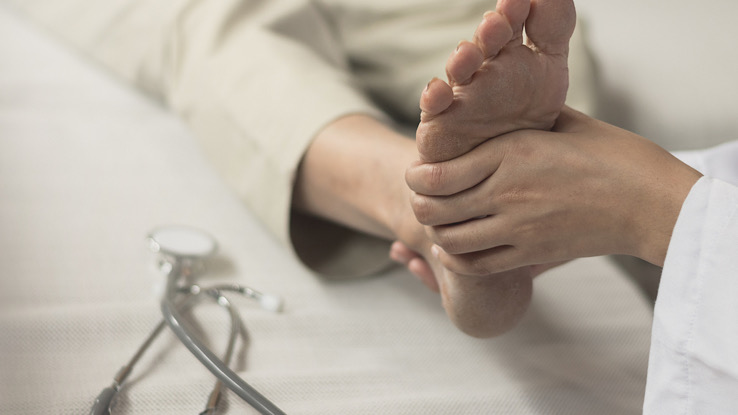Bone Spurs (Osteophytes)

Bone spurs, also known as osteophytes, are small growths on the bones within the spine and around the joints. Due to the name “spur,” many believe bone spurs are spiky or sharp; however, the name of this bone condition is misleading.
Bone spurs are usually smooth growths and can be painless. Some people with bone spurs may not even know they have them. If you have bone spurs and other conditions such as arthritis, they can be quite painful and affect your quality of life.
Causes of Bone Spurs
Most bone spurs occur due to normal wear-and-tear that the body experiences through aging, repetitive movement such as exercise, or conditions such as osteoarthritis. Osteoarthritis is associated with the breakdown of the cartilage that cushions the ends of bones, which in turn may lead to friction and the development of bone spurs. There is no definite known inherited component to the development of bone spurs. But, conditions such as osteoarthritis may occur within families, thus predisposing some people to bone spurs.
Location of Bone Spurs
Bone spurs can be painless and often do not cause any issues. Typically, pain-related symptoms of bone spurs are dependent on their location. The most common sites for bone spurs are the knees, vertebrae of the spine, hips, fingers, hands, and shoulders.
Bone spurs in the knee may cause irritation when you bend your knees or extends your leg. Similarly, bone spurs in other locations may cause irritation during the movement of the joints adjacent to the bone spurs.
Bone spurs on the spinal column
Bone spurs on the spinal column may cause space restriction in the area surrounding the spine, leading to spinal nerves becoming pinched. Pinched nerve roots typically lead to numbness and tingling in the extremities, which can be painful and cause imbalances in walking.
Bone spurs in the hip
Bone spurs in the hip region can restrict your range of motion, leading to problems walking, sitting, and standing from a seated position.
Bone spurs in the shoulder
When you develop bone spurs in the shoulder region, you may notice that your ability to use a full range of motion is affected. Additionally, you may have tendonitis, which is due to inflammation of the tendons supporting the rotator cuff muscles.
Bone spurs and osteoarthritis
If you have osteoarthritis, you may notice bone spurs occurring in your extremities, such as the bones of the fingers. These spurs may feel like hardened lumps under the skin’s surface and may be associated with a “knob-like” appearance of the fingers.
Other bone spurs
Bone spurs can occasionally separate from the main bone they are attached to. When this occurs, the broken pieces, known as loose bodies, can float around the joint or adhere to the joint lining. This situation can lead to intermittent locking of the joints as the floating pieces move around the joint area.
Symptoms of Bone Spurs
Although most bone spurs do not cause symptoms, they may trigger other conditions such as tendon inflammation, which does cause symptoms. Symptoms of bone spurs or bone spur-related conditions may include:
- Tingling, numbness, or burning in the extremities (hands and feet)
- Neck or lower back pain
- Loss of coordination
- Muscle cramps, spasms, or weakness
- Pain that radiates down the buttocks or legs
- Pain that radiates to the shoulders
- Headaches
- Difficulty controlling bladder or bowels
- Pain that increases with physical activity
- Pain that improves with rest or specific movements
Risk Factors
Risk factors for bone spurs beyond normal aging and osteoarthritis include:
- Disc or joint degeneration
- Having a close family member with osteoarthritis or bone spurs
- Sports-related injuries
- Motor vehicle injuries
- Poor nutrition
- Poor posture
- Structural abnormalities from birth
When To Seek Medical Care
If you are experiencing any of the symptoms described above and suspect that you may have bone spurs, make an appointment with your doctor. Early medical attention is critical as early treatment may slow or prevent further joint damage.
Your doctor may first attempt to rule out other medical conditions by performing a thorough medical history intake and physical exam. You should discuss any symptoms you have had, their duration, family history, and any medications you are currently taking.
Should your doctor suspect a diagnosis of bone spurs, they will likely refer you to a doctor specializing in joint disorders. There, you can discuss additional treatment methods to control any pain associated with your bone spurs. An x-ray will likely be performed to determine the precise location of the bone spurs and affected areas.
Treatment
Typically, bone spurs only require treatment if they cause significant pain. Bone spurs may also lead to associated arthritis symptoms, which may cause inflammatory pain. Minor inflammatory pain, such as joint pain, can be treated with appropriate doses of over-the-counter NSAIDs (non-steroidal anti-inflammatory drugs), such as ibuprofen.
Treatment for bone spurs depends largely on the location of the spurs as well as the severity of pain caused by the spurs. In most cases, the doctor may prescribe over-the-counter anti-inflammatory medicationsfor minor pain. However, more severe cases may require surgical removal of the spurs to alleviate pain.
Resource Links:
- “Bone spurs” via Mayo Clinic
- “Osteophyte (bone spur)” via NHS
- “Plantar Fasciitis and Bone Spurs” via OrthoInfo





